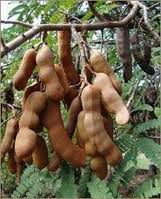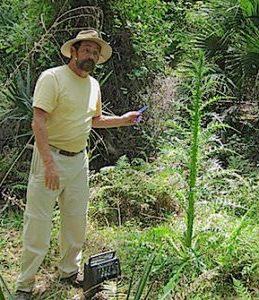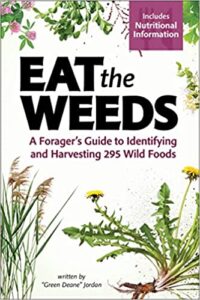
Ripe Gopher Apples, photo by Green Deane
Gopher apples are a chance upon wild edible. You can go for years not finding any, then find a patch abundant with the rare fruit. That was the case in Lori Wilson Park Cocoa Beach this past weekend where we found hundreds of ripe Gopher Apples. When I first started looking for the species it took me seven years before I found a ripe fruit to taste. The species is salt and fire tolerant but difficult to grow. ALso the species’ name was recently changed from Licania michauxii to Geobalanus oblongifolius, the latter not an improvement nor widely accepted. What gopher apples taste like is quite fluid ranging from bubble gum to soft plastic. Over-eating gopher apples might interrupt one’s heart rhythms particularly if eaten with tallow plums.
 More controversial yet easy to identify is the two-leaf nighshade, or armatillo aka Solanum diphyllum. Suspected in the poisoning of children and cattle most references say it is not edible but I know several adults who nibble on the ripe fruit. They contain solanine. The problem with children is that they are small and tend to eat way too many berries where as adults eat one or two. (Cattle also eat stems and leaves.) Like sweet mild little tomatoes a few ripe ones do not seem to bother adults (avoid if you have an allergy to the nightshade family.) Possible symptoms of poisoning are nausea, vomiting, and gastrointestinal distress. Skin can also manifest redness, itching and a rash. Long term use can cause liver damage. The fruit has been used as a laxative and green fruit externally for ring worm. Ripe fruit is also toxic to dogs.
More controversial yet easy to identify is the two-leaf nighshade, or armatillo aka Solanum diphyllum. Suspected in the poisoning of children and cattle most references say it is not edible but I know several adults who nibble on the ripe fruit. They contain solanine. The problem with children is that they are small and tend to eat way too many berries where as adults eat one or two. (Cattle also eat stems and leaves.) Like sweet mild little tomatoes a few ripe ones do not seem to bother adults (avoid if you have an allergy to the nightshade family.) Possible symptoms of poisoning are nausea, vomiting, and gastrointestinal distress. Skin can also manifest redness, itching and a rash. Long term use can cause liver damage. The fruit has been used as a laxative and green fruit externally for ring worm. Ripe fruit is also toxic to dogs.

Foresteria berries, photo by Green Deane
Foresteria are in the olive family. And the fruit of one was used for ink. The fruit is bitter, but so too is the common olive without brining. One Foresteria, F. neo-mexicana, was used like olives. Thus I brined F. legustrina fruit. Although small it had an acceptable flavor. Brining in this case meant soaking the fruit in salted water (10% solution) for a month and changing the solution every week. Salt is often used to reduce tannins and is part of the process of turning Java Plums into wine.

Tamarind fruit pulp and leaves are edible. Photo by Green Deane
Ripening now in different areas of the state are the aforementioned Java Plums. While fruiting heavily in the Port Charlotte area some fruit were just starting to ripen on the other side of the state in West Palm Beach. Astringent with tannins dozens of trees see their fruit rot on the ground every year, a similar situation with mango and star fruit trees. Also dropping fruit is the tamarind tree, usually used for seasoning the tart leaves are also edible.

Foraging classes are held in rain but not hurricanes. Photo by Nermina Krenata
Foraging classes: Dodging tropical storms and hurricanes is normal for this time of year. Classes for this weekend were previously schedule and cancelled because of Tropical storm Debbie. Hurricane Ernesto is not predicted to bother us this weekend.
Saturday, August 17th John Chestnut County Park: 2200 East Lake Road, Palm Harbor, FL 34685. Meet at the trail head of the Peggy Park Nature Walk, pavilion 1 parking lot, 9 a.m. to noon.
Sunday August 18th, Red Bug Slough 5200 S. Beneva Road, Sarasota. 9 a.m. to noon, meet at the bathrooms.
Saturday, August 24th Mead Garden, 1500 S. Denning Dr., Winter Park, FL 32789. Meet at the bathrooms. 9 a.m. to noon.
Sunday August 25th, Boulware Springs Park, 3420 SE 15th St., Gainesville, FL 32641. Meet at the picnic tables next to the pump house. 9 a.m. to noon.
For more information on these classes, to prepay or sign up go here. The cost is $30 per adult (the class is usually three hours long and examines five-dozen or so species.) If cost is a hardship email me at: GreenDeane@gmail.com.

Controversial Peppervine.
Putting on black fruit now is the controversial Pepper Vine, Ampelopsis arborea. It is closely related to the edible grape but also closely related to the toxic Virginia Creeper. It’s one of those plants that some folks say is definitely toxic and others say definitely edible. My personal experience is that it is not edible but I know some credible foragers who say they have eating the ripe berries for a long time with no issue. No doubt the problem has to do with annual calcium oxalate production. In small amounts it’s tolerable. In higher concentrations it can cause skin problems or internally upset digestion. Pepper Vine (so-called because the fruit can give a pepper-like burn) apparently can make little to a lot of the chemical each year, varying greatly. Another possibility is method of preparation. Some people juice the berries and let the juice sit in the refrigerator which allows the acid to precipitate. The juice is then carefully decanted through two coffee filters and used. If you do so proceed with caution. The other caution is that Pepper Vine and Wild Grapes can grow intertwined and you can get some Pepper Vine fruit in with your grapes. This also can happen with Virginia Creeper. Pick your grapes carefully.

Coffee Cherries are edible and nutritious.
An edible commercial species one sees now and then locally is coffee. We all know you can roast the seeds, but the red ripe fruit is very tasty. We also have two wild coffee species, their fruit is edible but unremarkable. The seeds are not edible, are a laxative, and have no caffeine. Cultivated coffee can be found from at least mid-state to the southern end, usually in someone’s yard. Get permission to harvest.

Green Deane Forum
Tired of Facebook or You Tube banning you? At least once a month or once a week, those media ban me, the last time because I wrote I wanted to kill all the ants in my back yard. The Green Dean Forum won’t ban you if you want to kill ants. Are you looking for a foraging reference? You might have a UFO, an Unidentified Flowering Object, you want identified. On the Green Deane Forum we — including Green Deane and others from around the world — chat about foraging all year. And it’s not just about warm-weather plants or just North American flora. Many nations share common weeds so there’s a lot to talk. There’s also more than weeds. The reference section has information for foraging around the world. There are also articles on food preservation, and forgotten skills.

You get the USB, not the key.
172-video USB would be a good end of spring present and is now $99. My nine-DVD set of 135 videos has been phased out. The USB videos are the same videos I have on You Tube. Some people like to have their own copy. Most of the 172 USB videos have to be copied to your computer to play. If you want to order the USB go to the DVD/USB order button on the top right of this page. That will take you to an order form.

Now in second printing.
EAT THE WEEDS, the book, 274 plants, 367 pages, index, nutrition charts and color photos. It’s available in many locations including Amazon. Most of the entries include a nutritional profile. It can also be ordered through AdventureKeen Publishing.

Tindora, or Ivy Gourd, is a hated and appreciated escaped vegetable. Photo by Green Deane
Tindora is ripening now which mean there’s plenty of green fruit to eat. Looking like short fat cucumbers Tindora is used like cucumbers until it ripens, then it is more like a sweet red pepper in taste and nutrition. On the invasive plant hit list tindora is basically disease resistant and does not have to be planted every year.
This is weekly newsletter #607. If you want to subscribe to this free newsletter you can find the sign-up form in the menu at the top of the page.
To donate to the Green Deane Newsletter click here.

